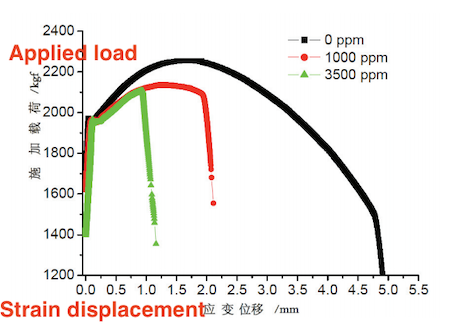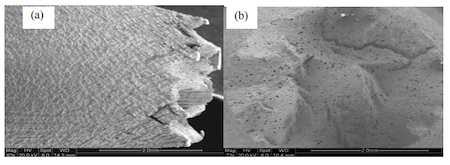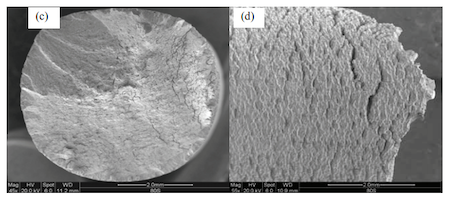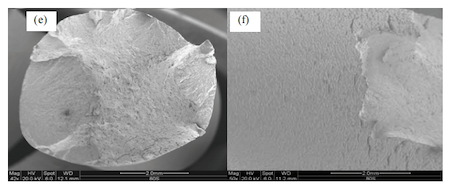Anshan Iron and Steel Seamless Plant has successfully trial-produced seamless oil pipes with enhanced mechanical properties and corrosion resistance by optimizing the design composition, smelting, rolling, and heat treatment processes in compliance with American Petroleum Institute (API) Spec 5CT standards. Inspection results confirm that the product's mechanical properties and acid corrosion resistance meet the requirements of API Spec 5CT as well as other anti-corrosion standards.
Table 2 Product performance requirements
| Steel Grade |
Yield Strength (MPa) |
Tensile Strength (MPa) |
Cross-sectional Hardness Value (HRC) |
| AG55S |
379–482 |
≥655 |
≤22.0 |
| AG80S |
552–655 |
≥655 |
≤23.0 |
| AG80SS |
552–655 |
≥655 |
≤23.0 |
| AG90S |
621–724 |
≥689 |
≤25.4 |
| AG90SS |
621–724 |
≥689 |
≤25.4 |
| AG95S |
655–758 |
≥724 |
≤25.4 |
| AG95SS |
655–758 |
≥724 |
≤25.4 |
| AG110S |
758–880 |
≥862 |
≤33.0 |
| AG80S-1Cr |
552–655 |
≥655 |
≤23.0 |
| AG80S-3Cr |
552–655 |
≥655 |
≤23.0 |
Table 3 Impact test requirements for products
| Grade |
Horizontal Impact Requirements (0℃, Full Size) |
Vertical Impact Requirements (0℃, Full Size) |
| AG55S |
Pipe body and couplings are implemented in accordance with the K55 steel grade in the ninth edition of API 5CT |
| AG80S, AG80SS, AG90S, AG90SS, AG95S, and AG95SS |
YSmin (0.00118t+0.01259) or 14J, whichever is larger |
YSmin (0.00236118t+0.02518) or 27J, whichever is larger |
| AG110S |
YSmin (0.00118t+0.01259) or 20J, whichever is larger |
YSmin (0.00236118t+0.02518) or 41J, whichever is larger |
The effects of different hydrogen sulfide concentrations on the slow strain rate tensile properties of
AG80S OCTG pipes were studied at a tensile rate of 5 × 10⁻⁶ mm/s. The corrosion media used included Solution A, Solution A with 1000 ppm hydrogen sulfide, and Solution A with saturated hydrogen sulfide (3500 ppm). The slow strain rate tensile curve of the AG80S OCTG pipe under these different hydrogen sulfide concentrations is shown in Figure 4. The area shrinkage and fracture time are presented in Table 4.

Figure 4 Slow strain rate tensile curve for the AG80S OCTG pipe
Table 4 Slow rate tensile properties of AG80S OCTG pipe under different hydrogen sulfide concentrations
| H₂S Concentration (ppm) |
Original Diameter (mm) |
Average Diameter (mm) |
Reduction of Area (%) |
Strain (mm) |
Fracture Time (h) |
| 1000 |
6.36 |
5.6 |
22.61 |
2.1095 |
112.52 |
| 3500 |
6.36 |
5.96 |
12.18 |
1.1614 |
63.91 |
Fracture Analysis
Figures 5 to 7 show the slow-rate tensile fracture morphology of the AG80S OCTG pipe under different hydrogen sulfide concentrations. In Solution A with zero hydrogen sulfide concentration, the fracture morphology exhibits a cup-cone shape. Significant plastic deformation occurred prior to fracture. Under tensile stress, only a small amount of hydrogen atoms diffused into the material, causing stress concentration that triggered ductile fracture and formed numerous dimples. The crack source formed inside the material. As the hydrogen sulfide concentration increased, the fracture morphology showed no significant plastic deformation before fracture, shifting from ductile to brittle fracture. The primary crack source gradually shifts from corrosion pits to hydrogen-induced cracks. The hydrogen-induced cracks on the specimen surface increase, and as crack depth grows, a multi-source fracture morphology develops. The expansion zone is small, while the intermediate instantaneous fracture zone is large, with secondary cracks in the fracture zone gradually increasing. The source of the secondary cracks primarily originates from hydrogen-induced cracks and surface corrosion pits.

Figure 5 Slow-rate tensile fracture of AG80S OCTG pipe in Solution A corrosive medium (0 ppm)

Figure 6 Slow-rate tensile fracture of AG80S OCTG pipe in Solution A + 1000 ppm H₂S corrosive medium

Figure 7 Slow-rate tensile fracture of AG80S OCTG pipe in Solution A + saturated H₂S corrosive medium
The SSC test was conducted on steel pipes using Method A, in accordance with the American Society of Corrosion Engineers standard NACE TM0177-2005, "Test Method for Resistance to Sulfide Stress Corrosion Cracking of Metallic Materials in H₂S-Containing Environments." Solution A, consisting of H₂S-saturated 5% NaCl and 0.5% glacial acetic acid, had a pH of 2.7 before the test and 3.9 after the test. The pipe nut and welded joint specimens were loaded under horizontal stresses of 72% Re L and 90% Re L, respectively, for 720 hours. The test results showed that SSCC cracking did not occur in any sample tube heads or welded joints under either stress load. These results indicate that the developed anti-corrosion products exhibit excellent anti-SSC properties.
Table 5 Test methods for sulfide stress corrosion cracking resistance
| Grade |
Test Standard |
Sample Size (mm) |
Loading Load (% Ysmin) |
Solution |
Loading Time (h) |
| AG55S |
NACE TM0177 Method A |
6.35 |
80% |
Solution A |
720 |
| AG80S |
NACE TM0177 Method A |
6.35 |
80% |
Solution A |
720 |
| AG80SS |
NACE TM0177 Method A |
6.35 |
90% |
Solution A |
720 |
| AG90S |
NACE TM0177 Method A |
6.35 |
80% |
Solution A |
720 |
| AG90SS |
NACE TM0177 Method A |
6.35 |
90% |
Solution A |
720 |
| AG95S |
NACE TM0177 Method A |
6.35 |
80% |
Solution A |
720 |
| AG95SS |
NACE TM0177 Method A |
6.35 |
90% |
Solution A |
720 |
| AG110S |
NACE TM0177 Method A |
6.35 |
85% |
Solution A |
720 |
| AG80S-1Cr |
NACE TM0177 Method A |
6.35 |
90% |
Solution A |
720 |
| AG80S-3Cr |
NACE TM0177 Method A |
6.35 |
90% |
Solution A |
720 |
(1) Anshan Iron and Steel Seamless Factory has the production technology capabilities for AG80S (SS), AG80-1Cr, AG80-3Cr, AG90S (SS), AG95S (SS), AG110S (SS), and AG125S steel grade anti-corrosion products.
(2) The production processes adopted by Angang, including ironmaking → steelmaking → out-of-furnace refining → continuous casting and rolling → piercing → continuous rolling → non-destructive testing → quenching → tempering → surface inspection, are feasible, and practice has proven that they are suitable for batch production.




